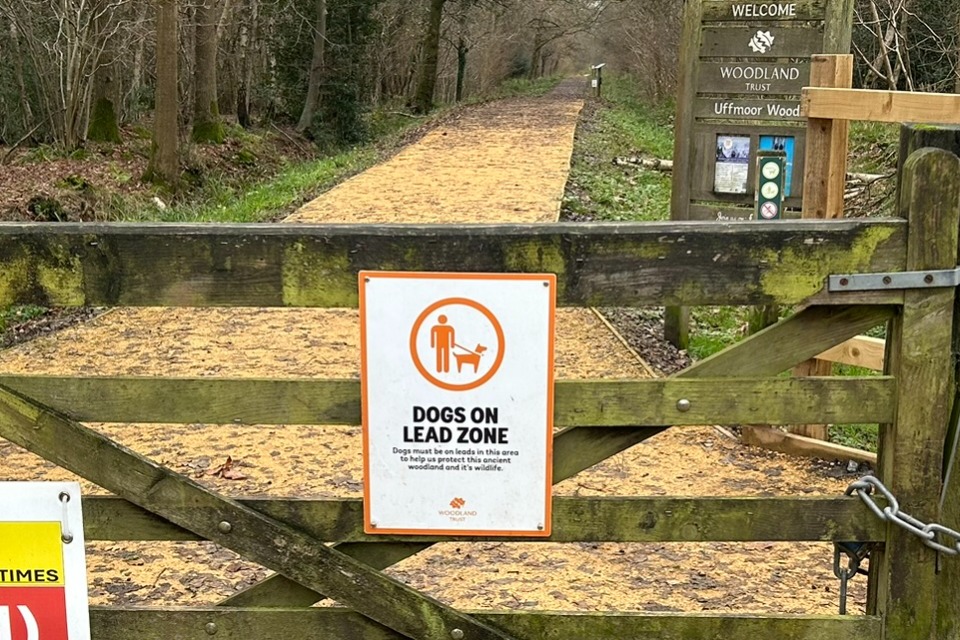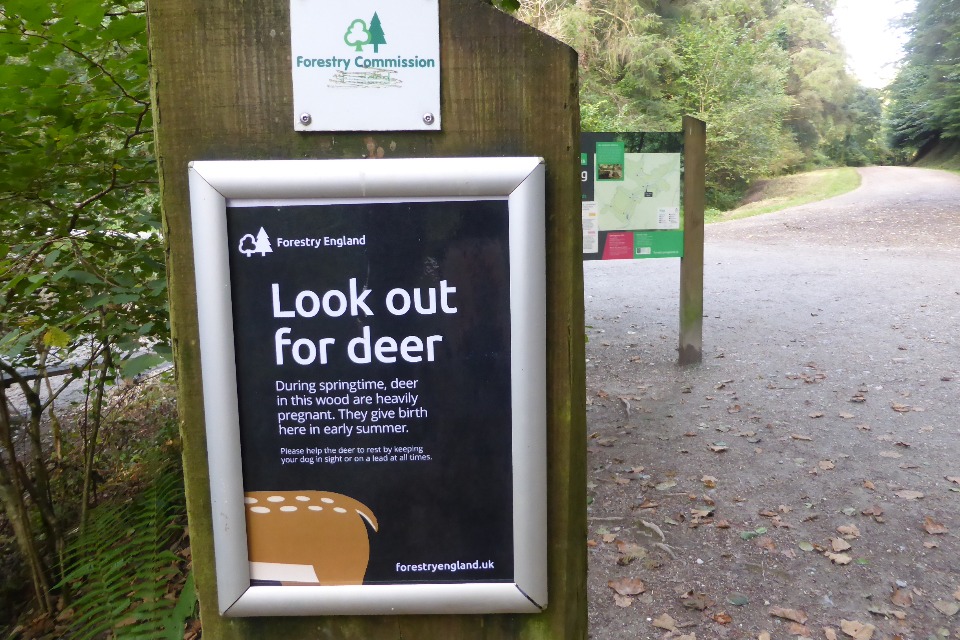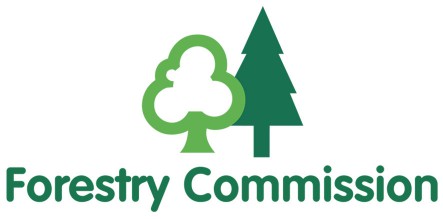Dogs in woodland: wildlife, livestock and forestry operations
Published 16 January 2025
Applies to England
Dogs in woodland can sometimes have a negative impact on sensitive wildlife, such as unattended infant deer or ground-nesting birds being flushed from their nests. Dogs can also affect rare reptiles and plants, wildlife and livestock.
These impacts are not always obvious to an individual dog walker, who may not realise the harm their dog could cause to wildlife when out of sight. They may also be unaware of ongoing forestry operations or that other visitors might not want dogs to approach them.
Providing clear information will help visitors follow the requirements for your woodland.
Reducing hazards to wildlife, habitats and livestock
On protected sites, such as Sites of Special Scientific Interest (SSSIs), features can be disturbed or damaged, for example by dogs digging near ancient trees or bluebells. It can be a criminal offence on the owner, for example if a dog destroys or damages features of an SSSI or injures a wild bird or its nest.
You should contact Natural England for advice.
Nutrients from dog waste can also affect the habitats of threatened species such as some butterflies.
However, there can also be benefits arising from regular dog walkers reporting damaging antisocial behaviour, wildlife crime, poaching, fly-tipping or pollution. Dog walkers reporting wildfires before they take hold can also benefit wildlife and habitats.
Grey squirrels and rabbits are often seen as a pest species. Dog owners may think it’s helpful for dogs to chase them, but this can also disturb protected species.
Adders and wild boar can be seen as a threat to dogs and dog walkers may not be sympathetic to their conservation. Make sure accurate and credible information is provided on how to avoid these animals.
To help make your management measures most effective:
- identify and prioritise specific dog walker behaviours that help or hinder good management
- consider any grant conditions or statutory requirements, such as livestock welfare and health and safety
Managing visitors and dogs in new and established woodlands
Visitors can help protect wildlife and livestock, and avoid conflicts with other visitors or forestry operations, when they have clear information and advice. This could include:
- using short leads
- using a different route
- using busier routes, where deer are less prevalent, and avoiding off-lead exercise in quiet areas during dawn and dusk (to avoid dogs chasing deer)
- keeping ‘paws on paths’ - throwing balls and toys along paths and tracks, instead of into vegetation
- only allowing their dogs to swim in ponds designated for dog access
You can advise visitors with dogs when to do this by giving clear signs and information at the times and in the locations where they’re needed.

Example sign showing the start of a ‘dogs on leads’ zone. Crown copyright.
Offering off-lead walks in less sensitive areas has been shown to be an effective way to reduce disturbance to wildlife and livestock. Visitors are less likely to follow a requirement to always have their dog on a lead. This is because most visitors with dogs will want some off-lead exercise. Identify any less-sensitive times and areas where dogs can be exercised off-lead. Use signage and information to let people know where these areas start and finish.
Ensure off-site and online information about your woodland is clear about wildlife and livestock sensitivities. This can influence a visitor’s plans before they arrive.
Signs can also highlight the off-site information available, for example:
‘For more information about where you and your dog can go and what you can do, please see … (refer to website, social media or visitor guides)’.
Check with the local authority and any grant funders to ensure you are aware of any access rights or conditions you need to respect.
Signage
Define wanted behaviour from dog owners across the whole woodland, such as keeping dogs under effective control to make sure they don’t approach wildlife, livestock, horses and other people unless invited. Be clear and avoid vague terms such as ‘be responsible’, which can be misinterpreted.
You can also use messages from the Countryside Code, adapted to suit the circumstances of your woodland, such as:
- ‘Keep all dogs in sight and close-by: use a lead if they don’t always return when called.’
- ‘Control dogs so they don’t approach or chase cyclists, horses, wildlife or livestock.’
- ‘Make sure your dog does not stray from the path (or area where you have right of access).’
For seasonal or sensitive times, be clear what is required. For example, ‘Please keep dogs on paths and tracks between 1 March and 31 July to protect birds nesting on the ground.’

Example sign text 'look out for deer' with an explanation of the presence of vulnerable wildlife and how dog owners should behave. Copyright Steve Jenkinson.
Using the least restrictive requirement that will solve the problem is likely to have much better compliance, such as requiring ‘dogs on leads/paws on paths’ only at the times and places where they are needed. Asking for dogs to be kept on paths and tracks can be more effective than stating ‘on-lead’.
Remove signs no longer needed. Leaving seasonal signs up all year (such as for lambing or bird nesting), or signs about forestry operations that have already finished, undermines confidence and compliance with your other signs.
Monitoring and maintenance
Adverse changes in habitats and wildlife behaviour are sometimes attributed solely to public access and dog walking, when they can also be affected by other factors. Record what visitors do before management changes and at regular intervals afterwards. This will give meaningful, low-cost monitoring of the changes you’ve introduced.
If behaviour appears to be improving, it’s good practice to communicate that to regular visitors with a ‘thanks for your help’ message.
Legal resources and further guidance
Read these resources on laws relating to interactions with wildlife, livestock, other visitors and forestry operations:
- the law relating to protection of livestock from disturbance by dogs
- requirements for when and where dogs must be kept on a lead on Countryside and Rights of Way Act access land Open access land: management, rights and responsibilities
- the Department for Environment, Food and Rural Affair’s manual on legal options and good practice: Dealing with irresponsible dog ownership
- Forest Research’s guide on managing public safety on harvesting sites
- the Health and Safety Executive’s guide on managing visitor safety during forestry work
You should also familiarise yourself with the Countryside Code, for visitors and land managers. Good management is more effective than a legal approach.
Read more about legal resources related to dog walking on Woodland management, infrastructure and signage: visitors with dogs.
Read more about managing visitors with dogs in your woodland.

